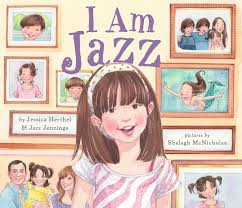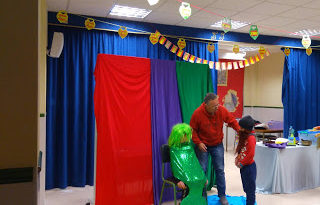TRANSGENDER CHILDREN AND EDUCATION.
I am Jazz tells in a simple way the story of a girl that from the age of two knew that she has a girl´s brain in a boy´s body. She liked pink and dressing up as a mermaid and did not stand boy´s clothing. It caused confusion in her family until a doctor said that Jazz was transgender and had been born that way. The message of the story is simple and powerful: being difference should not a problem, self-acceptance and that of others is the first step to be happy.
The constitutional principles under which the educative legislation is grounded are clear: all citizens are equal before the law with no discrimination due to any personal circumstance. Obvious as it seems, this includes respect for and support towards transgender children, leading schools to strive for the inherent values to the principle of equity.
Therefore, our duty as teachers is to foster the accomplishment of the students´ rights, ensuring the optimal learning conditions and the inclusion of all children, whatever their circumstances. In this sense, along this paper we shall analyse the main methodological guidelines to be put into motion, as well as some examples of adequate foreign language (FL) tasks to this purpose.
The term transgender refers to a person whose gender identity does not correspond to the sex they were assigned at birth; and this fact can take place at early ages. As it can be inferred from the case study title, we may think that the family accept and support the reality they are going through, and that some kind of medical or psychological advice has already been implemented.
Nevertheless, returning to the key point of transgender children at early ages, there are plenty of considerations to be covered under the scope of an inclusive education which respects children´s rights in a democratic society. We have to admit that schools and other settings may be particularly challenged by the specific needs of trans children. In supporting a trans child, schools and individuals may have to re-think views and practices on gender and identity which have been accepted as ‘standard’ for a long time. This can be challenging, but no pupil should be made to feel that they are causing problems or that they owe anything to their school in return for being treated with the equality they deserve. Gender is an important part of our identity and developing a positive sense of gender identity is part of growing up. However, there is a growing recognition that there is a spectrum of gender, which is wider and more complex than just male and female.
As we know, the umbrella term “transgender” describes people whose sense of gender is deemed as being different to the sex they were assigned at birth. However, wherever possible, individuals should be given opportunities to say how they identify or describe themselves (self-identified gender).
When considering trans identities, we must understand that there is a difference between sex and gender. Sex refers to our biology (chromosomal make up, genitalia, hormones) and is often used for the physical anatomy of a person (for example, male, female). Gender identity is understood as our internal sense of self as well as how we express ourselves in terms of masculinity and femininity. Children and young people may question their gender identity for a range of reasons and this may not mean they are definitely trans or will go on to transition. The main thing is to validate the young person’s identity as it is now, and support any changes that may arise as they come to explore their gender identity further.
Teachers should think carefully about everyday language in school and try to use it not to reinforce a binary approach to gender. A classic example is ensuring the playhouse is not called ‘the Wendy House’ or certain books and toys are not labelled or color-coded for boys or for girls. This reflection on the use of language when working with groups of children is good practice to line up in pairs, with someone the same height or someone with the same birthday month rather than always as boys and girls.
Is it that easy? Absolutely not. This situation requires a common response on the part of the school community and establish daily action lines which affect the normal development of trans students at schools. A prime example may be the use of toilets. Students should have the right to access the toilet that corresponds to their gender identity. Any child who has a need or desire for more privacy, regardless of the underlying reason, should be provided access to a single stall toilet, but no pupil or student must be forced to use such a toilet. In an ideal situation, schools may provide single stall toilets that can be used by all. In this sense, some valuable actions for the school management team to promote can revolve around a threefold strategy:
- “Educate” the teaching staff about transgender issues in general, and focus on the particular case we have at school. In this regard, the school´s Orientation Team may be a key resource to psychologically support this child and technically guide teachers.
- Work closely with the trans child and family to smooth social transition and favour communication.
- Establish an effective communication plan that sets what, when and who concerning the information to be communicated.
Of course, listening to the student and family is of utmost relevance. Thus, asking simple questions like: How can we help you? Have you talked to other people or professionals? Which name or pronoun do they wish to be called at school? Equally important is to let them know that the school actions will not approach the situation as a problem, but rather as an opportunity to challenge and enrich the school community.
It also Seems clear that inclusive messages can reinforce the school´s commitment towards gender equality and inclusion. Some tips may be:
- Emphasize classroom messages like: “all children are/can/should…”, “there´s no such thing as boys or girls colours, colours are just colours”.
- Let students (especially the transgender one) that teachers value strengths and appreciate their unique qualities, personality, preferences, and the like.
- Interrupt comments based on gender stereotypes.
- Ensure supervision and control of all school´s spaces on the grounds of a safe school environment.
- Develop classroom activities that foster gender inclusion (i.e related stories).
- Group students without attention to gender, such as table groups, letters in their names or colors of their clothes. Avoid situations that force children to make gendered choices, such as boys line up here and girls line up there.
Without a shadow of a doubt, building a strong sense of community and a climate of acceptance in the school and classroom is a critical proactive strategy for creating a safe environment for all children. This can be taken down to everyday practice through a vast array of classroom tasks, like using stories, games, songs to create context that permit slipping into the matter subtlety, like roleplays, oral presentations, cooperative work, and of course being a model as a teacher.
Contributing to schools that nurture curricular achievement, provide physical and emotional safety and promote acceptance of all students are common goals for all teachers. For students to feel supported and empowered to express their identities and interests at school, educators must create gender-inclusive environments that affirm all children and that help moving beyond the limitations of gender stereotyping.
We should not dismiss the notorious effect that the teaching actions may exert upon the transgender issue. Being realistic, we have to assume that this situation may arise a series of problems we shall have to tackle with, because change is always hard, especially for children at early stages; although, paradoxically sometimes they seem to understand changes better than adults.
Moreover, transgender children or those who are transitioning, quite often deal with teachers who have never had a similar situation in their classrooms. In this line, we must keep in mind that listening from the very first moment and nor leading the conversation with the student and family is paramount. In doing so, we must show an open mind, without minimizing or dismissing their feelings and emotions.
Fortunately, teachers can find plenty of resources. Some examples of stories may be:
- “Annie’s Plaid Shirt”, where Annie´s mum tells her what to wear for her uncle´s wedding;
- “The Boy and the Bindi”, in which a five-year-old South Asian boy becomes fascinated with his mother’s bindi, the red dot commonly worn by Hindu women and wishes to have one of his own;
- “BunnyBear”, a lovely story of a bear who feels more like a rabbit;
- “Introducing Teddy”, a book which introduces children in the understanding of gender identity in a heart-warming way.
- “It Feels Good to Be Yourself” is a story by Theresa Thorn with a deep message: Some people are boys. Some people are girls. Some people are both, neither or somewhere in between.
- “Jacob’s New Dress” by Sarah and Ian Hoffman. Jacob loves playing dress-up, when he can be anything he wants to be. Some kids at school say he can’t wear «girl» clothes, but Jacob wants to wear a dress.
- In Crayon´s Story, by Michael Hall, a blue crayon mistakenly labeled as «red» suffers an identity crisis. Almost everyone tries to “help” him be red until a friend offers a new perspective.
We cannot end up this article without stressing the initial golden rule, based on teaching actions that respect human and children´s rights, whatever their personal circumstances.
More information about us:
facebook.com/OposicionesInglesRP/
Twitter: @OposIngles
https://twitter.com/OposIngles
Instagram: https://www.instagram.com/oposiciones_ingles
Video by Teachings in Education
Video by: https://www.youtube.com/channel/UCHZeKyjqpK9diTD1g4yDl5g




